
INDIANAPOLIS (Aug. 8, 2024) — Today, at the Indiana State Fair the Indiana State Department of Agriculture (ISDA) presented John Baugh, Director of Agricultural Services and Regulations at Purdue University, and Ed Ebert, Senior Director of Market Development for the Indiana Soybean Alliance and the Indiana Corn Marketing Council, with the state’s highest agricultural honor, the AgriVision Award.
Now in its 18th year, the award is presented to individuals who have made significant contributions to the agriculture industry and their communities.
“It was an honor to present John and Ed with the AgriVision Award,” said Lt. Gov. Suzanne Crouch, Secretary of Agriculture and Rural Development. “Their vision has guided the foundation of this great industry, and not just statewide, but nationally. We would not be where we are today without their leadership and commitment to supporting agriculture.”
John Baugh has been a tireless advocate for Indiana agriculture for decades. A steady presence at the Indiana Statehouse for the last 35 years, his impact can be seen on legislation that directly impacts agriculture and rural communities. He has, and continues to work closely with state agencies, including the ISDA, State Board of Animal Health, Office of the State Chemist, and many others, to ensure the laws, rules and regulations passed by the Indiana Legislature are based on both science and common sense.
Baugh is a tireless advocate for Purdue University, Purdue Agriculture and agricultural education throughout the state. Through his efforts, Vincennes and Purdue created joint facilities located adjacent to the Purdue Southwest Agricultural Center in Knox County. Those facilities have enhanced Purdue's impact on agriculture in the region and strengthened the long-standing relationship between the two institutions. Additionally, he played a key role in assisting the college’s efforts to secure legislative support for the new veterinary hospital. Over the years, Baugh has been the lead for lobbying to secure funding to support the Animal Disease Diagnostic Laboratory (ADDL) in West Lafayette and the Heeke Diagnostic Laboratory located at the Southern Indiana Purdue Agricultural Center (SIPAC) in Dubois County.
Throughout Baugh’s career, he has served as a tireless advocate on behalf of Indiana rural communities. When considering his exhaustive contributions to forming the Indiana Corn Checkoff Law, Indiana Grain Indemnity Fund, rural broadband efforts, chemical applicator licensing issues affecting producers and citizens alike, livestock challenges and agronomic sustainability opportunities, to name a few, Mr. Baugh has proven a reliable source of information for his fellow board members over the years.
“The strength of Indiana’s agricultural industry comes from the dedication, ingenuity and perseverance of Hoosiers and visionaries like John and Ed,” said Don Lamb, director of the Indiana State Department of Agriculture. “Both awardees have dedicated their careers to moving the industry forward, and it was a privilege to honor them today.”
Ed Ebert goes many, many miles to serve the soybean and corn farmers of Indiana. He is always seeking new markets to move tons of Hoosier-grown soybeans and corn to customers both nearby and around the globe. Ebert’s duties are aimed at helping to increase farmer's bottom line. To accomplish those goals, he goes the extra mile – in a big way. Ebert has buyers interested in Indiana’s corn and soy crops and related products on six continents, and he has traveled the circumference of the Earth more times than he can count.
In a typical month, you might find Ebert working on a deal with large scale venues to use high oleic soybean oil in their concessions, promoting food-grade soybeans in Indonesia, promoting soybean oil to the food industry in Korea, educating chefs in Vietnam about U.S. Poultry and Pork, promoting U.S. soy in aquaculture diets in China, promoting chicken, duck and turkey in Colombia, talking container export opportunities with the Ports of Indiana, leveraging contacts to coordinate international trade team visits to Indiana farms, promoting the benefits or ethanol and biodiesel or advising the ISA and ICMC CEO Courtney Kingery about crop yields and bushel prices.
Ebert represents Indiana producers well on a statewide and global stage. In fact, in 2023, he and the Indiana Soybean Alliance and the Indiana Corn Marketing Council engaged with 31 countries representing 57% of the world’s population and 36% of gross domestic product to work on projects to move the pile. He has been an invaluable source of knowledge on international commodity markets and is an asset to all Indiana corn and soybean farmers.
For more information about the AgriVision Award, please click here or visit www.isda.in.gov.

INDIANAPOLIS (Aug. 9, 2024) — Yesterday, Lt. Gov. Suzanne Crouch and the Indiana State Department of Agriculture announced the winners of the 2024 Indiana Agriculture Photo Contest. The winning photographs will be displayed in the lieutenant governor’s Family of Business offices in Indianapolis throughout the next year.
“Indiana has so many gifted photographers that truly know how to showcase Indiana agriculture through their talents,” said Lt. Gov. Crouch, Indiana’s Secretary of Agriculture and Rural Development. “This year's winning photos perfectly captured the Hoosier spirit and farming tradition to the highest degree.”
The winning photos were chosen from hundreds of entries in the following four categories: Agritourism, Conservation, Faces of Agriculture and On the Farm. Two winners were selected from each category, along with two winners overall.
To be considered, the photo had to be taken in the state by an Indiana resident. The photos were evaluated by a panel of independent judges based on creativity, composition and category representation.
“This year we received nearly 400 photo submissions in the Indiana Agriculture Photo Contest,” said Don Lamb, Indiana State Department of Agriculture Director. “Each of the submissions received captured the essence of Indiana agriculture and we look forward to sharing the images with you throughout the year."
The following list includes the photo contest winners for 2024:
Agritourism Category
- "Rising Above" by Bethany Hudspeth from McCordsville
- "Sunset Fair Fun" by Andrew Forrester from Madison
Conservation Category
- "Mallard Missile" by Sara Day from Muncie
- "The Proud Mother" by Richard Bennett from Indianapolis
Faces of Agriculture Category
- "An Evening Walk" by Linsie Middlesworth from Marion
- "Mini….Faces of Ag" by Jadin Wolf from Marengo
On the Farm Category
- "Buddy Seat Rider" by Marie Kohlhagen from Rensselaer
- "Focusing on Warmer Weather" by Zakery Helms-Judkins from Pendleton
Overall Category
- "Electric Pivot" by Tom Jones from Star City
- "Like Father, Like Daughter" by Jadin Wolf from Marengo
To view the winning photos, click here or visit isda.in.gov. To view photos of the photographers from the award presentation, click here.
The Harrison County Cattleman's Association and Purdue Extension-Harrison County are hosting a Field Day at Cameron Churchill's Farm (4880 Adams Rd., Depauw, IN) on Saturday, August 24, from 10 a.m. to 2 p.m. Topics include: beef cattle production, rotational grazing, and cattle minerals. There is no fee to attend, but RSVP's are appreciated by calling the Extension office at 812-738-4236 or


This informal report by the Division of Entomology & Plant Pathology is a commentary on insects, diseases, and curiosities division staff encounter on a week-to-week basis. Comments and questions about this report are welcome and can be sent to your respective Inspector.
Our Website
Inspector Territories
Eric Biddinger (Nursery Inspector & Compliance Officer) -
Saw a few unusual things over the last week. First is an unusual leaf feeding on honey locust. The damage was isolated to this tree. I haven’t figured this out yet.
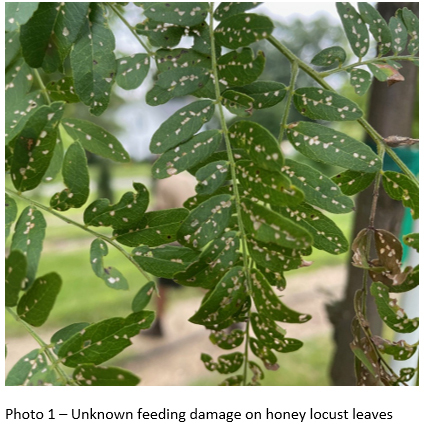
Next was a pretty heavy infestation of tuliptree scale which was, again, pretty isolated. Tuliptree scale is not unusual in itself, but it has been a while since I have seen this level of infestation in a nursery. The ants running up and down the trunk were the first indication that I needed to take a closer look.
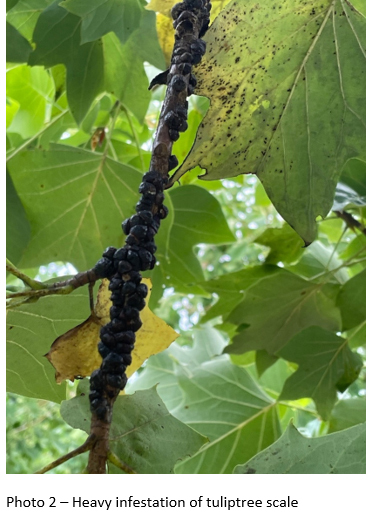
While bagworm is quite common on evergreens, it is a rarer occurrence to find them on deciduous trees. Here I found bagworm on beech. The damage was starting to get serious. Just another example of why you need to stay vigilant while scouting.

Finally another honey locust issue. The stem galls and leaf distortion were occurring on every locust this nursery received in this shipment leading us to believe the issue came from the supplier. PPDL said this looked just like Imprelis herbicide injury, but given this product was removed from sale in 2012, we have another mystery on our hands. The lesson here is that it is always beneficial to keep track of the sources of your nursery stock.
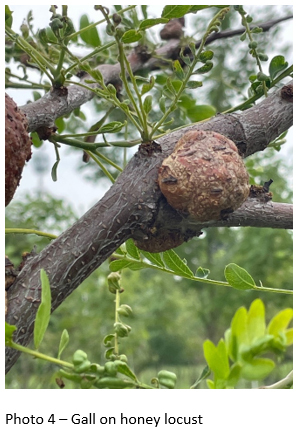
Angela Rust (Nursery Inspector & Compliance Officer) -
The imported willow leaf beetle (Plagiodera versicolora) is not native to North America and the exact native range in Europe and Asia is not known. These specimens were found on white willow and ‘Golden Corkscrew’ willow. Poplar and willow species are common hosts. Adults and larvae both feed on the leaves of trees. Larvae skeletonize the leaves and adults chew holes. These beetles overwinter in loose bark and other sheltered areas around the trees. Damage from feeding may cause leaves to turn brown and fall early. Several insecticides labeled for control of leaf beetles are effective in controlling heavy populations.
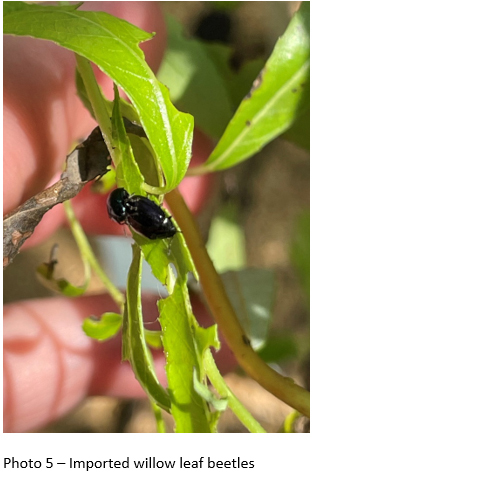
Jared Spokowsky (Nursery Inspetor & Compliance Officer) -
I saw a few things of interest this past week. The first was a nursery owner who called me about some white pines he wanted me to take a look at. The pines were sitting in a container yard had some needle discoloration and were showing signs of stress. The owner was told by a sales rep he should consider disposing of all the white pines because it was needle cast. Thankfully the owner wanted a second opinion. Upon arriving I found eight to ten (of about 50) white pine with bark beetle infestation which was causing pretty severe wilting. I found no other signs of disease and little to no sign of beetle attack on the healthy trees. This nursery had been having an issue getting adequate irrigation on their containerized material and this is what I suspect predisposed the trees to the beetle attack.
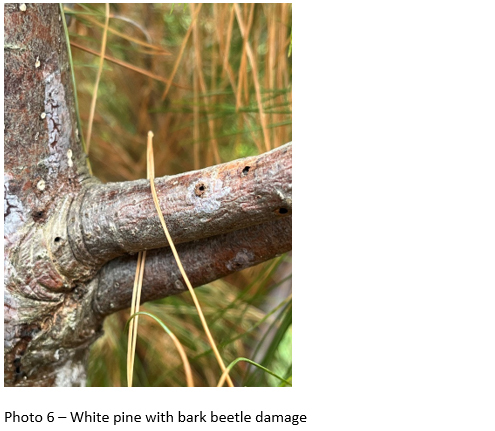
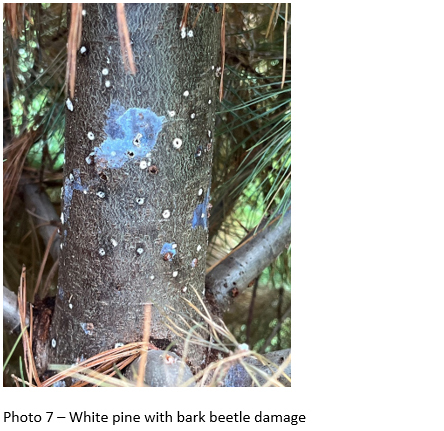
The next thing of interest was a red oak with a fairly substantial wound which could have been mechanical or disease-caused but had a copious amount of sap coming out. This was a hot spot for various insects feeding on the sap including horse flies, other smaller flies, yellow jackets, and bald-faced hornets. Upon closer inspection, it appeared the wound was moving, and it turned out that quite a few maggots were feeding in the sap. I had expected that I might find some sap beetles feeding in the wound. Sap beetles in the family Nitidulidae are attracted to wounds on oaks and are the primary means of spreading new pockets of oak wilt. Oak wilt will create fungal mats under the oak bark which are called pressure pads.
The pads will split the bark of the tree open where it begins to weep sap which attracts sap beetles. The beetles then come into contact with oak wilt spores which they can carry to an uninfected wounded tree, which can start a new pocket of wilt. A couple weeks back I had sent a sample of chestnut oak to the lab for a possible oak wilt infection which came back positive. Once established the primary means of controlling oak wilt is to remove infected trees and sever root grafts with a vibratory plow or trenching machine. Historically wound dressing paint was used to seal pruning wounds on trees. This practice is no longer recommended with the exception of pruning oak while sap beetles are active.
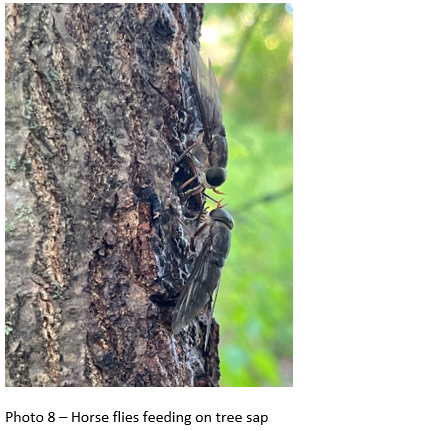
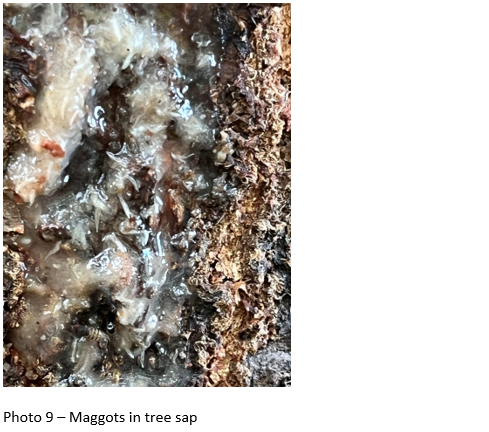
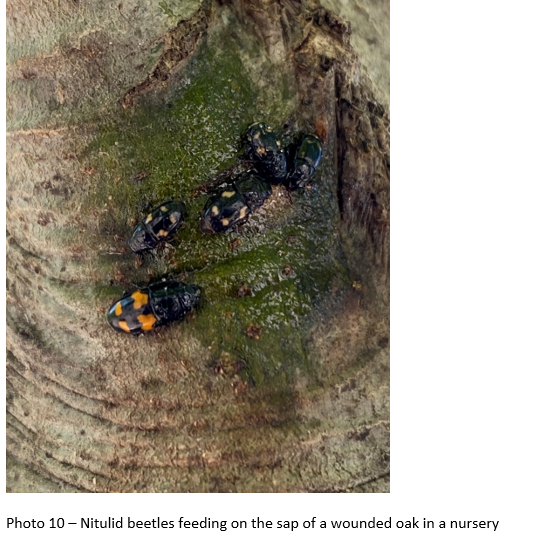
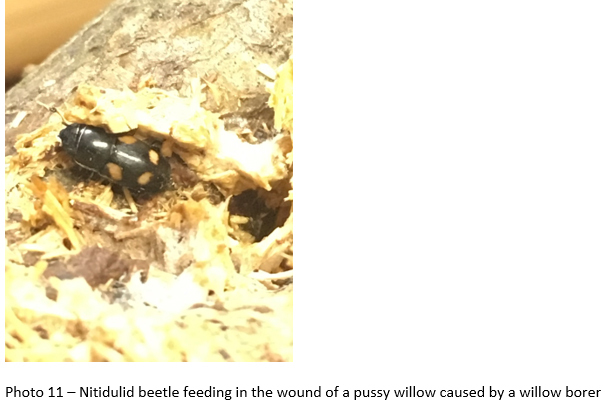
I also found a young example of one of our more unique plants, dodder. It is a parasitic plant, except a short-lived root system, which derives all of its nutrition from its host plant. Because of this, it is typically yellow to orange in color because it does not contain any chlorophyl.

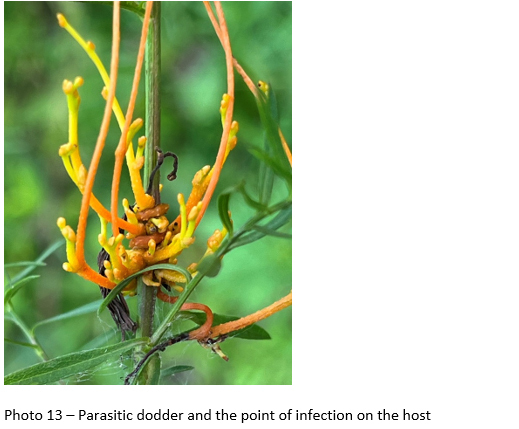
Lastly, I am still seeing quite a bit of bees actively foraging on various species. So far in SE Indiana, I wouldn’t say we are in a dearth yet because of all the rain. If you’re looking for another possibility to plant for bees you should take a look at Clethra alnifolia, also called sweet shrub or sweet pepper bush. Clethra is a small to medium shrub which is in full bloom now. It isn’t a powerhouse when it comes to honeybee attraction, but I see consistent activity on it along with other bees and butterflies. It produces a good show of small white to sometimes pink/reddish panicle flowers on some cultivars. It will tolerate heavy clay, shade, and wet soils. It struggles in drier areas with more sun exposure.
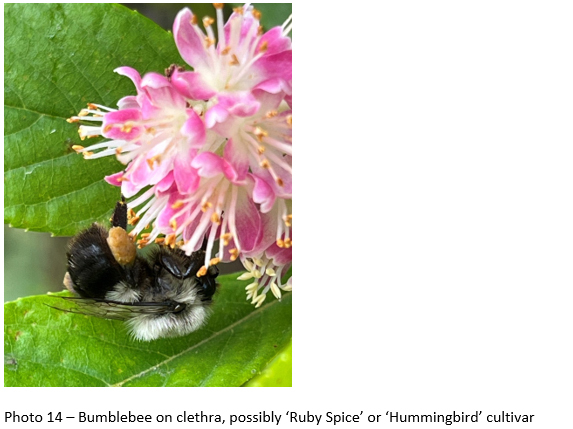
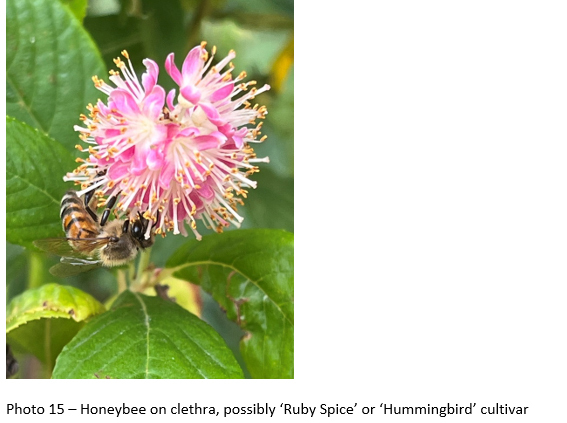

This informal report by the Division of Entomology & Plant Pathology is a commentary on insects, diseases, and curiosities division staff encounter on a week-to-week basis. Comments and questions about this report are welcome and can be sent to your respective Inspector.
Our Website
Inspector Territories
Eric Biddinger (Nursery Inspector & Compliance Officer) -
A couple of administrative things. Please welcome Gary Moughler as he replaces Vince Burkle as nursery inspector in the northeast area. Some of you with a really long memory might remember Gary from his days as a USDA officer working on the emerald ash borer program and before that as a nursery inspector with us in the very area, he will be taking over again.
Welcome back, Gary! This transition will allow Vince to fully move into his role as assistant director and survey coordinator. The territory map and contact information on the website will be updated shortly.
Second, the Indiana State Fair starts this weekend and once again DEPP will be hosting the State Fair Butterfly Garden and invasive species booth in the DNR Building. Please stop by and say hello. The DNR Building is open from 9 a.m. to 8 p.m. The State Fair runs Aug. 2-18 (closed Mondays).
Kallie Bontrager (Nursery Inspector & Compliance Officer) -
Those of you up here in the northwest corner of the state might be noticing flagging/dead tips on trees scattered around the area. This damage is from the periodical cicada brood 13 that emerged in LaPorte, Porter, and Lake counties earlier this summer. It is caused by the female cicada laying eggs in the limbs.
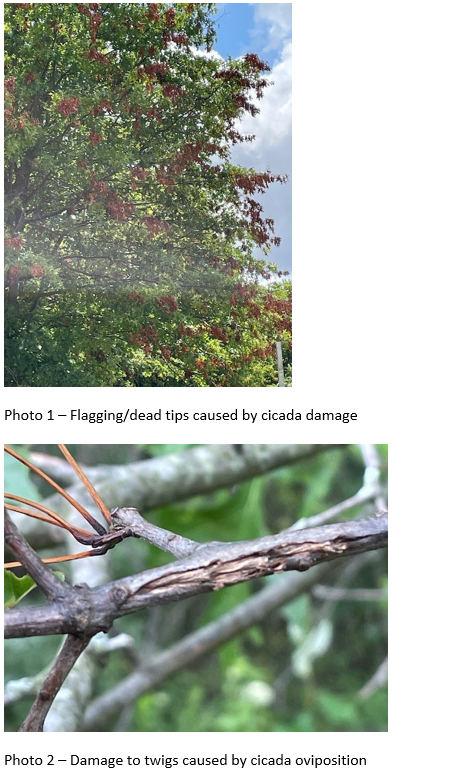
Japanese beetles have been patchy but where I have found them but are more concentrated than in the last few years. Other problems I saw included flea beetle damage on weigela and hawthorn, oak slug sawfly on white oak and red oak, psyllid nipple gall, and potato leafhopper on several varieties of red maple.
Angela Rust (Nursery Inspector & Compliance Officer) -
A problem that I see with Sedum and other succulents in the nursery is powdery mildew. This pathogen thrives in high humidity conditions. You may notice scab-like lesions that appear white, gray, or brown on leaves. Keep plants separated with sufficient distance to maintain good air circulation and keep them in sunny areas. Neem oil or copper-based fungicides can work well for the management of this problem. Be sure to follow all label instructions, especially in hot conditions, so leaves are not burned.
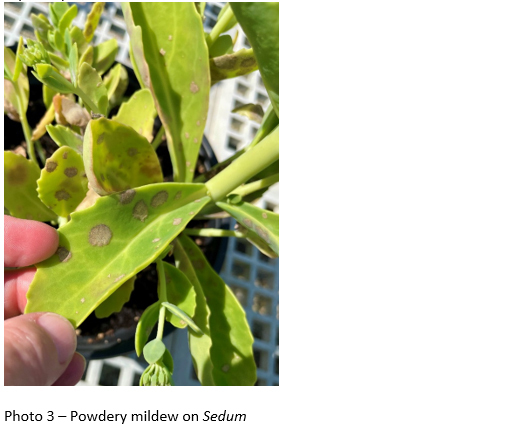
False oleander scale is an armored scale insect that I see frequently on Magnolia nursery stock. This pest has around 100 known host species. For management guidance on armored scales see this link.

Diane Turner (Nursery Inspector & Compliance Officer) –
Bagworms, Thyridopteryx ephemeraeformis, are known to feed on many species of plants; however, evergreens are very commonly attacked throughout Indiana this time of year. The larvae live inside the spindle-shaped bags they construct from the host plant. These bags serve as protection from predators.
Eggs of this insect that have overwintered in last year’s bags begin to hatch in early June. As the larvae feed on the host plant and grow, they spin their bags and continue to enlarge them as they grow. The primary harm to the host plant is defoliation leading to it becoming weakened and unsightly.
The dark-colored larva crawls part-way out of its protective home to feed and quickly retreats inside when disturbed. Management of this defoliator includes hand-picking bags from plants with light infestations to using a biorational or synthetic insecticide on the foliage with heavier populations. For more information see this publication from Purdue Extension.

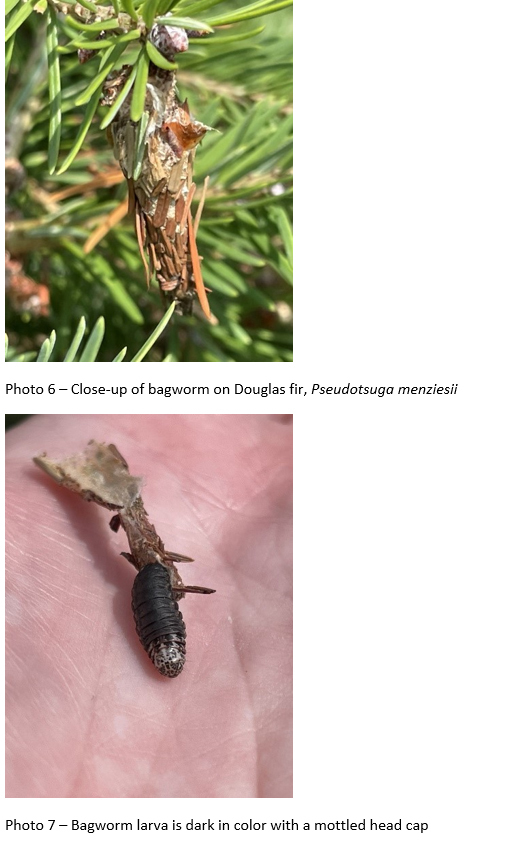
Will Drews (Nursery Inspector & Compliance Officer) -
While performing some tree of heaven (Ailanthus altissima) surveys recently, I’ve noticed some damage to them that thankfully isn’t spotted lanternfly. There’s one other insect in our area that has been around for much longer and considers the invasive tree of heaven a host plant, and that is the ailanthus webworm moth (Atteva aurea).
Originally more of a Central American species (up to Mexico and southern Florida), the ailanthus webworm moth expanded its range northwards to feed on tree of heaven, once it was introduced to the U.S. in the late 1700s. Before that, the ailanthus webworm moth mostly was found on paradise tree (Simarouba glauca) and a couple of other species in the Simarouba family. However, once tree of heaven was introduced and its range quickly expanded all the way to Florida, the ailanthus webworm moth learned to use this new species—which is also in the Simarouba Family—as a food source, and the moth’s range expanded quickly to most of the invaded range of tree of heaven.
Unfortunately, the ailanthus webworm moth tends to not do enough damage to the invasive trees to cause any mortality. However, on some small seedlings, the damage can be quite extensive and cause the tree to lose most or all of its new growth for a season.
Here are some of the pictures I have taken recently of most of the life stages of ailanthus webworm moth on a small patch of tree of heaven.


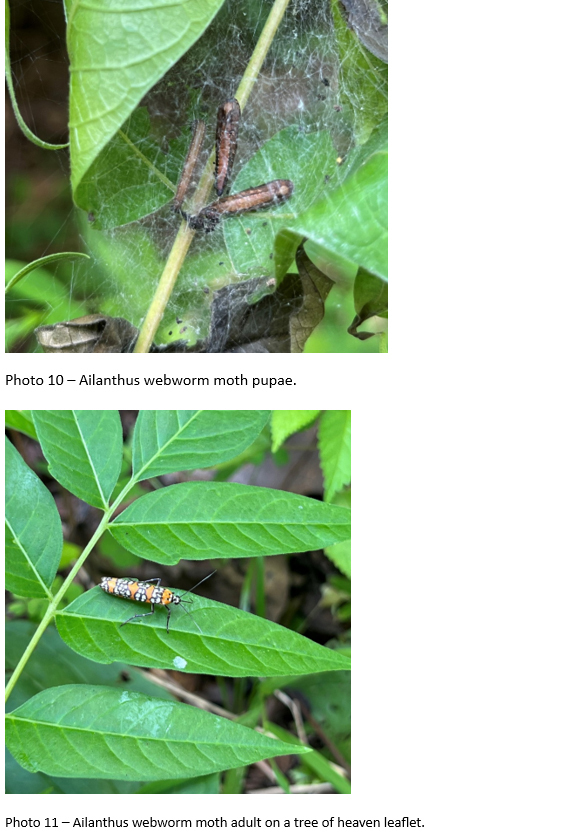
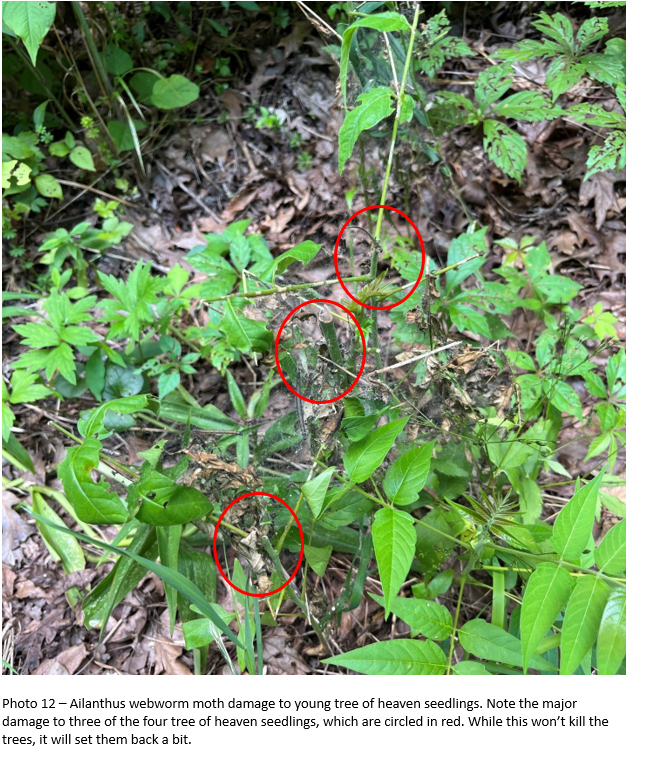
Kristy Stultz (Nursery Inspector & Compliance Officer) -
Leaf galls are typically not considered to be detrimental to a plant’s overall vitality. In most cases, they are aesthetically unpleasing but aren’t going to cause long-term harm. This is especially true when considering the overall percentage of affected tissue versus healthy tissue over the entirety of the plant.
This is the case with oak flake galls, Neuroterus quercusverrucarum family Cynipidae. These tiny, non-stinging wasps cause small fuzzy white galls on the underside of leaves of several species of oaks including white oak (Quercus alba), swamp white oak (Q. bicolor), bur oak (Q. macrocarpa). The wasps lay eggs on the underside of leaves in the spring and white, fluffy galls form in summer. As the season progresses, the galls will slowly turn various shades of brown.
When in high numbers, the galls can look pretty gnarly and be very concerning to homeowners.



SalemLeader.com
Leader Publishing Company of Salem, Inc.
P.O. Box 506
117-119 East Walnut Street
Salem, Indiana. 47167
Phone: 812-883-3281 | Fax: 812-883-4446
Business Hours:
Mondays through Fridays, 9:00am - 5:00pm
News:
news@salemleader.com
Office:
office@salemleader.com
Publisher:
publisher@salemleader.com
Business
- More Business News
- Go To Guide
- Business Directory
- Real Estate
- Auctions
Education
- More Education News
Opinion
- Editorials
- Letters to the Editor
- Columns
- Unsung Heroes
- Days Gone By
- In the Garden
- Guest Columns
- Reader's Poll
- Salem Leader Forum
- Questions and Answers
Church
- Bible Aerobics
- Church News
- Church Directory

